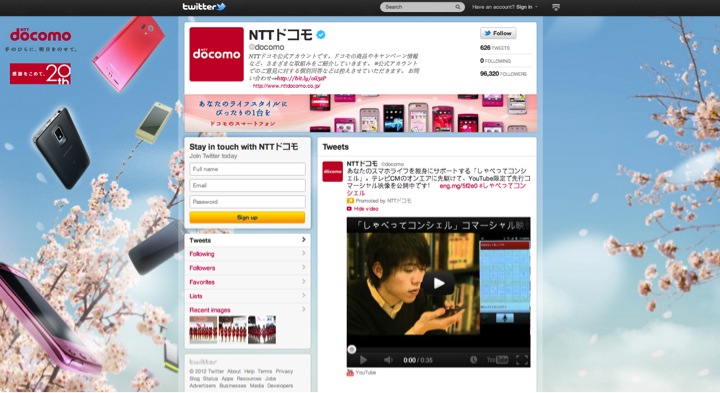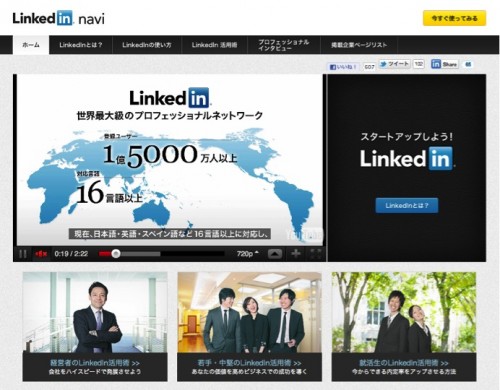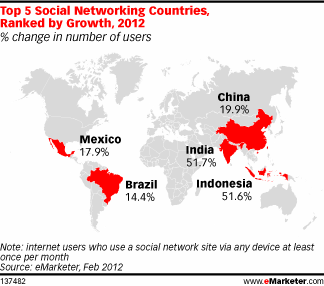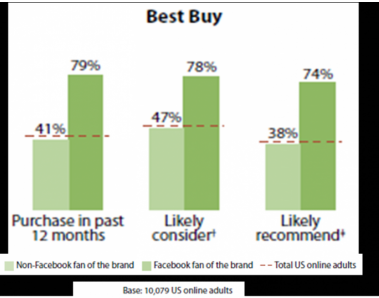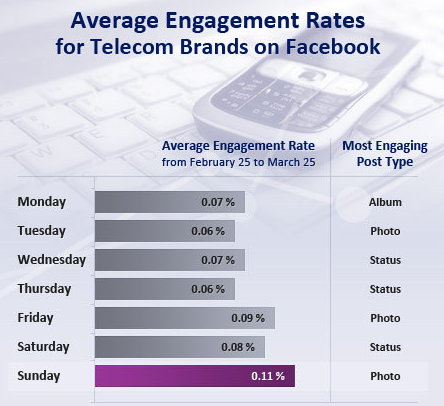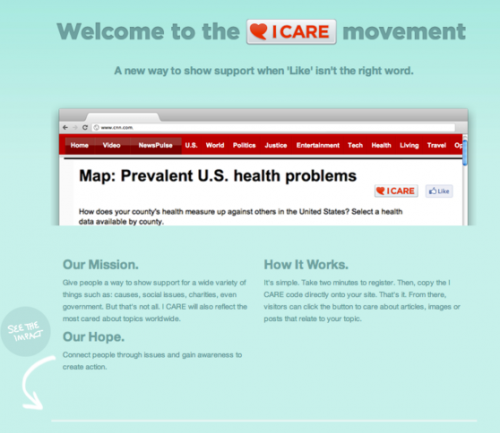We Are Social Asia Midweek MashUp #23
Twitter introduces brand pages in Japan
Japan is the first market in Asia where Twitter is introducing brand pages after their first launch in the US in December 2011. The three companies who will first use Twitter brand pages are Docomo, Japan’s largest mobile operator, convenience store chain Lawson, and Warner Entertainment Japan. This isn’t surprising given the popularity of the microblogging service in Japan, which sees 29.9 million users. We wonder which large Japanese corporations are next in line to make use of Twitter brand pages, given its hefty “price tag” as companies wishing to even qualify for this special feature have to had spent US$25,000 in Twitter advertising, be it for sponsored tweets or trending topics.
Number of hours spent online by Asian Internet users
A recent regional survey conducted by online security provider Norton by Symantec reveals that Singaporeans spend an average of about 9 hours a day online, compared to 8.4 hours for respondents in India, and 7 hours for those in Japan. The survey also revealed that 68% of respondents cannot live without the Internet for more than 24 hours.
Tudou launches video e-commerce feature with Pepsi
Tudou has recently launched an integrated e-commerce feature on its website on 30th March, and its current collaboration with Pepsi demonstrates how the feature connects the viewer to the brand’s Tmall store. By clicking on certain Pepsi-branded items, viewers will be taken directly to the product’s page on Tmall. We haven’t chanced upon any of these e-commerce enabled videos, but it seems similar to “the world’s first shoppable music video“, which allows viewers to click-through on items featured in the video itself to Ssense.com, an online luxury retailer. This could be a really powerful tool if the e-commerce integration isn’t obtrusive to one’s viewing experience, and it’ll be interesting to see whether e-commerce enabled videos will take off in China or other parts of the world.
LinkedIn’s guide for Japanese users
LinkedIn has launched a Navi site which serves as an online how-to guide to explain to Japanese users how they can benefit from its professional network and demonstrate how it works. LinkedIn is probably trying to encourage an increase in user numbers as it still has less than 500,000 registered members on its network in Japan, whereas other international social networks such as Facebook and Twitter have taken off in Japan.
Social networks grow userbase and engagement
eMarketer posted an interesting study of which countries they expect to grow the fastest this year in terms of social networking users – the growth in the Asian market once again underscores how important it is. India is looking to increase its social networking population by 51.7%, and Indonesia follows closely with 51.6%.
The science behind ‘Why tweets go viral?’
According to researchers at Indiana University, the likelihood of a post going viral has more to do with chance than the actual content or the author who started the meme. Researchers created a virtual model of a social site and pumped memes into the program to see how the network reacted. They discovered that the model behaved similarly to real networks, and showed that chance plays a much bigger role in whether or not a meme goes viral than was previously thought.
Facebook fans are your best customers
Forrester have released a nice bit of research which makes an important point:Facebook fans are your most loyal advocates and customers, providing they’re true fans. In other words, there’s lots more to be said for having 20,000 really engaged fans who love the brand, than 80,000 fans who are only there because they click on ads.
Of all the different modelling factors used, being a Facebook fan was by far the best factor in predicting whether somebody will purchase from the brand as shown by the example of Best Buy:
Sunday is the most social day on Facebook
According to Socialbakers, the best time for brands to engage fans is Sundays. The company reviewed user activity by the week and hour for over 10m Facebook pages and places to reveal a snapshot of the best times of the week to score maximum engagement for brands within social media. Perhaps the most interesting finding was from the Telecoms industry, and how much more popular posts on Sundays were compared to any other day of the week.
Eye movement study reveals six must-know things about Facebook Pages
A new study that tracked the eye movement of users visiting six branded Facebook Pages suggests the new Timeline layout is ‘flawed’ as features are overlooked or unnoticed. Although it’s a catchy stand-out quote, the reality is that the study looked at just six brands. Sure, some people might overlook the cover photo – but that’s the challenge for marketers: creating an interesting cover photo, and using Timeline to enhance their Facebook Page.
Facebook + Instagram
Facebook announced yesterday that they have bought Instagram in a $1 billion deal. Mark Zuckerberg announced the news on his Facebook profile:
I’m excited to share the news that we’ve agreed to acquire Instagram and that their talented team will be joining Facebook. For years, we’ve focused on building the best experience for sharing photos with your friends and family. Now, we’ll be able to work even more closely with the Instagram team to also offer the best experiences for sharing beautiful mobile photos with people based on your interests.
We’re looking forward to working with the Instagram team and to all of the great new experiences we’re going to be able to build together.
It appears the deal has been in the pipeline for some time, as the companies have been working together for the past few weeks on Open Graph integration.
The plus side of the deal for users is that it allows Instagram to roll out a Timeline application without friction for users but the news has not been widely welcomed, with Twitter users planning an #instaExodus this Friday, although whether this will gain enough users to cause Facebook any worries is doubtful.
All in all, it’s been a particularly good week for Instagram after their Android app launched with a bang, bringing 3 million new users to the photo-sharing network overnight. Instagram is now the world’s biggest mobile-only social network (outside of China) with 32 million users, and it could realistically reach 50 million users by the end of the year.
Updates to Facebook Insights
Facebook is upgrading its Insights to better capture the viral, organic and total impressions of posts. It’ll be attributing impressions from post shares into impressions from the original page post and also capturing impressions on an ongoing basis instead of the previous 28-days cut off. That last bit is probably the most interesting: it means the value of social SEO will be much more easily discernable to community managers.
LinkedIn’s new Group Search
LinkedIn has updated the way users can search through the 1.2 million groups on the site. The upgraded tool now searches the content of conversations and not just the title, whilst also showing which of your connections are in the group, making it easier to find quality content relating to you.
Google+ grows again, adds Google Analytics and Google Contacts
Rebuffing the continuing media slant that Google+ is a ghost town, new figures have emerged which suggest the site grew 27% in March to 61 million monthly unique visitors. There’s certainly a case to be made that if the media were more positive about Google+, more people would use it and so on.
Nevertheless, Google continues to try and make Google+ more appealing to marketers. According to leaked slides, they plan to add Google Analytics to pages which will help track growth, visits, etc. In addition, they’ve incorporated Google Contacts so that when you click on a user’s profile, their address and details will be visible to you if they’re a friend of yours.
Pinterest keeps on growing
According to Experian, Pinterest is now the 3rd most popular social site in America beating out Google+ and LinkedIn and experiencing a 50% increase in traffic between January and February alone.
Nonetheless, the value of this research is limited – everybody knows Pinterest has been growing, it’s whether it can keep growing which is the big question, and it’s the next six months which will be the tipping point for Pinterest.
In other news, Pinterest users can now edit their board covers. Pinterest has just released a customisable feature that allows users to choose the pin that appears on the cover of their Pinterest boards. By hovering one’s mouse over the board, an “Edit Board Cover” button will appear, which enables users to skim through all their pins to select a cover image, as well as adjust the position of the thumbnail for a better fit. This will give users slightly more control over the appearance of their profile pages given that board covers used to reflect the last pin made by users by default.
Citroen crowd-source car design
Citroen has launched a Facebook app called the C1 Connexion Project, which will let Facebook fans design a version of the C1, with the most popular going into production. Citroen has allowed users to customise six elements on the car in one of the best attempts at crowd-sourcing we’ve seen.
Nissan’s Bollywood Facebook campaign
Nissan has released a five minute video which came from a Facebook campaign that recruited 20 people to star alongside Bollywood actor Ranbir Kapoor in the video. The campaign was a great success, with 2,300 entries and manifold new fans driving Nissan to be the top car brand in India.
Interactive billboard which changes with Facebook likes
Bronx shoes, a South African shoe brand, have launched a brilliant new campaign: a billboard which grows a beard according to the number of Facebook likes the Bronx Page gets. If the campaign goes viral, the billboard really could be a hair-raising prospect.
MTV Voices includes ‘I Care’ button
Alongside the ubiquitous Facebook ‘Like’ button, the updated MTV Voices hub features a newly launched ‘I Care’ button. Clicks on the button will be aggregated on a new site which will reflect ‘the most cared about topics worldwide’.
Reebok partners with PeerIndex for reputation-based giveaway
Reebok has teamed up with PeerIndex to offer free personal training sessions and shoes to those who are influential online about fitness. Reebok aims to drive positive brand association and traffic to the PeerIndex microsite through the discussion generated on social media, but as seems wont with this type iof campaign, the actual story hook is limited.
Government uses anti-government hashtag to respond
After last week’s leaked proposals against the UK government’s plans to snoop on what their citizens do online, a sarcastic hashtag called #telldaveeverything emerged, mocking David Cameron’s desire to know all about our lives.
Interestingly, the official Home Office account used the hashtag to respond – and considering the number of people monitoring it, this was quite a social media savvy response. Shame the original policy isn’t.
How Starbucks embraces social media
Aside from the many Instagrams of people drinking coffee, Starbucks has achieved real success in social media. Much of the reason for this is the brand’s openness. Many brands stay quiet on controversial issues to try not to alienate customers, whereas Starbucks embraces these issues.
While there’s clearly scope for negative responses to the positions Starbucks takes, Morgan Arnold makes a very good point:
Because consumers’ emerging awareness that their clothes, food, computers, and coffee actually come from somewhere, and that the processes of delivering those things are fraught with all kinds of ethical and political questions, means that brands will have to increasingly engage with consumers over these questions. It’s the Internet, in large part, which has helped provoke this consumer awakening – and it’s social media that will keep the debate going. Companies would do well to understand that real consumer engagement might mean more than just funny tweets and exclusive bargains.
